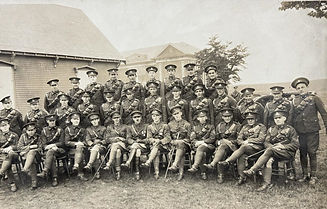
_Field_Artillery_.png)
1st Field Regimental Association

9-inch gun at York Redoubt,1873
- Army Museum, Halifax Citadel

Bewteen World War 1 and World War 2

Sergeants and non commissioned members, Gagetown 1988.

Members of 1st Field Regiment on exercise, 2025 - 5th Canadian Division Public Affairs Branch.
1st Field Regiment Royal Canadian Artillery
The origin of the Halifax Volunteer Artillery cannot be easily determined. The first non-permanent military force in Halifax was based on “levi-en-masse”. This required that all male between 16 and 45 serve in defence of the colony. Within a short time, businessmen saw a social relationship with the military as a means of establishing business contacts. Entering the military social sphere and forming “militia” units in which they and their associates could purchase commissions accomplished this.
The Halifax Volunteer Artillery was likely one of these units. The training of volunteers in “specialist” trades allowed for rapid augmentation of the British regulars, who were too few to man all the guns in the Halifax defences. As well, it is probable that a field battery was in existence in 1776.
The first official recognition of the unit was recorded in Governor Sir John Wentworth’s report to London in April 1791. Wentworth had been ordered to raise a force of 1000 men to defend the colony and reported that he had “700 good militia…including a battery of Artillery under Captain Tremaine”. In addition, he had 1000 men in the Nova Scotia Legion of Militia located in the Bay of Fundy area, which included a company of “horse” and two batteries of artillery.
The Halifax Battery in Wentworth’s report continued to serve throughout the Napoleonic era. Meanwhile, with the re-organization of the colony’s defence forces, Halifax now had five regiments, each of five companies. One of these, the 1st Halifax Regiment of Militia, included the Halifax Volunteer Artillery. Halifax gunners served under this name until June 14th , 1865, when the “1st Brigade of Halifax Militia Artillery, and 300 men took their place along side the RA gunners, ensuring that all guns were manned. The remaining four batteries were designated to form a reserve in the Citadel. On September 10th , 1869, the three militia artillery brigades in Halifax were amalgamated to form the Halifax Brigade of Garrison Artillery, which, on December 9th , 1870, was designated the “1st Halifax Brigade of Garrison Artillery”. In 1885, two batteries of this unit served in the northwestern Rebellion. The next few years were to see changes once again, the unit becoming the “1st Battalion, Garrison Artillery” in April, 1892, and two years later on December 28th , 1893, the “1st Halifax Regiment of Garrison Artillery”.
The “1st Halifax” was called out for active service at the outbreak of The First World War. The regiment was to remain on active service throughout the war, and to provide drafts of trained troops to assist in forming the 9th Siege Battery, and to provide replacements for other siege units in France. One draft helped to form No. 6 Company, Siege Artillery, which served in St. Lucia.
After the armistice, the Regiment returned to militia status. More name changes were to follow with the unit becoming the “1st Halifax Regiment, Canadian Garrison Artillery” on February 2nd , 1920, and on July 1st , 1925, the “1st Halifax Coast Brigade, Canadian Artillery”. It was under this name that the regiment was placed on active service in 1939. 87 Battery was authorized on 15 August 1939 as the ‘87th Field Battery, RCA’ through the disbandment and conversion to artillery of elements of ‘The King’s Canadian Hussars (Armoured Car)’ (originated 1 December 1903) and allocated to the 14th Field Brigade, RCA.
During the Second World War, the regiment was called upon to man the Halifax defences once again. As in World War I, the Regiment was assigned the boring, but necessary task, of home defence. Throughout the war, the regiment sent troops to other units for service overseas. Another name change followed on May 29th, 1942, when the regiment became the “1st ( Halifax) Heavy Anti-Aircraft Regiment, RCA”. With a change from 3.7 inch guns of British design to 90mm American equipment, the regiment was re-named the “1st (Halifax) Medium Anti-Aircraft Regiment, RCA” on August 22nd , 1955."
The current designation of the “1st Field Regiment, Royal Canadian Artillery ” occurred on November 1st , 1960, when the Regiment was issued 105mm howitzers and was amalgamated with the 36th Medium Anti-Aircraft Regiment, RCA of Eastern Passage, Nova Scotia. In the early 2000s, 1st Field Regiment and 87th Independent Battery were amalgamated by operational command. Today, the senior batteries of the regiment consist of 51st Battery, and 87th Independent Battery from Yarmouth.





